Electrical components are the building blocks of any electronic circuit, each serving a specific function to ensure the proper operation of the system. Understanding the most common electrical components and their roles is essential for anyone interested in electronics, engineering, or automation. Below, we’ll explore some of the most widely used electrical components, their functions, and how they contribute to the overall working of an electrical system.
1. Resistor
A resistor is one of the most fundamental electrical components. It resists the flow of electric current, limiting or controlling the amount of current that passes through a circuit.
Function:
Resistors are primarily used to control voltage and current levels within a circuit. They dissipate energy in the form of heat and help protect sensitive components from receiving too much current, which could cause damage.Types:
- Fixed Resistor: Has a set resistance value that cannot be changed.
- Variable Resistor (Potentiometer): Allows for adjustment of resistance.
- Thermistor: A temperature-sensitive resistor where resistance varies with temperature.
Applications: Used in voltage dividers, current limiting, and signal conditioning.
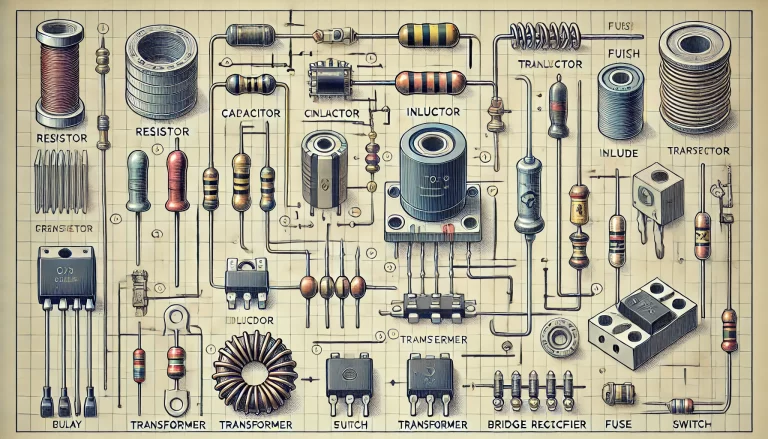
2. Capacitor
A capacitor is a device that stores electrical energy in an electric field. It temporarily holds electric charge, then releases it when needed.
Function:
Capacitors are used for storing energy, filtering signals, and stabilizing voltage and power flow. They smooth out fluctuations in electrical signals and provide filtering in power supplies to remove unwanted noise.Types:
- Ceramic Capacitor: Small, non-polarized, used in high-frequency circuits.
- Electrolytic Capacitor: Larger, polarized, and typically used for power supply filtering.
- Film Capacitor: Offers high stability and is used in precision applications.
Applications: Used in power supplies, audio systems, and for signal coupling or decoupling in circuits.
3. Inductor
Inductors are passive components that store energy in the form of a magnetic field when current flows through them.
Function:
Inductors oppose changes in current, making them useful for filtering high-frequency signals or storing energy in devices like transformers or motors. They can smooth out the ripple in power supply circuits and are often used in combination with capacitors to form tuned circuits.Types:
- Air Core Inductor: Simple and cheap, used in RF circuits.
- Iron Core Inductor: Provides higher inductance for power applications.
Applications: Commonly used in power supplies, radios, and transformers.
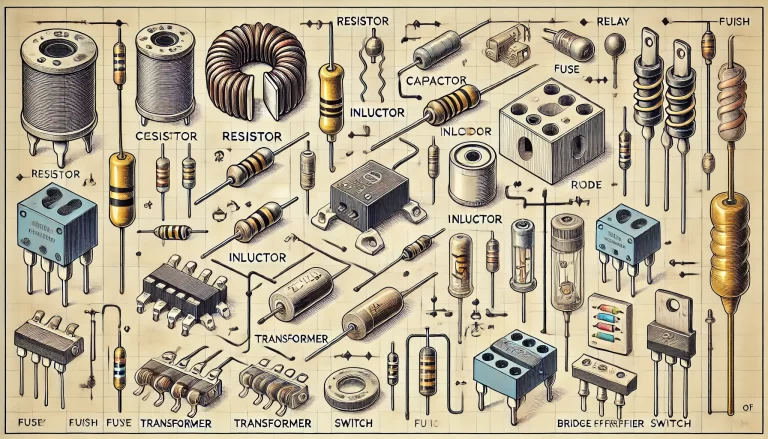
4. Diode
A diode is a semiconductor device that allows current to flow in one direction only, blocking current in the opposite direction.
Function:
Diodes are primarily used for rectification, converting alternating current (AC) to direct current (DC). They are also used to protect circuits by preventing reverse current, which can damage sensitive components.Types:
- Standard Diode: Allows current to flow in one direction.
- Light Emitting Diode (LED): Emits light when current flows through it.
- Zener Diode: Allows current to flow in the reverse direction when a specific voltage is reached, used for voltage regulation.
- Schottky Diode: Known for its fast switching speed and low forward voltage drop.
Applications: Power rectification, signal demodulation, and LED displays.
5. Transistor
A transistor is a semiconductor device used to amplify or switch electronic signals.
Function:
Transistors can be used as electronic switches in digital circuits or as amplifiers to control the flow of current. They are the building blocks of all modern electronic devices, including computers, smartphones, and other digital systems.Types:
- Bipolar Junction Transistor (BJT): Has three terminals (emitter, base, collector) and is used for amplification and switching.
- Field Effect Transistor (FET): Uses an electric field to control current flow. It has high input impedance and is used in sensitive circuits.
- MOSFET (Metal-Oxide-Semiconductor FET): A type of FET with very high efficiency and is widely used in power electronics.
Applications: Used in amplification, switching circuits, and signal processing.
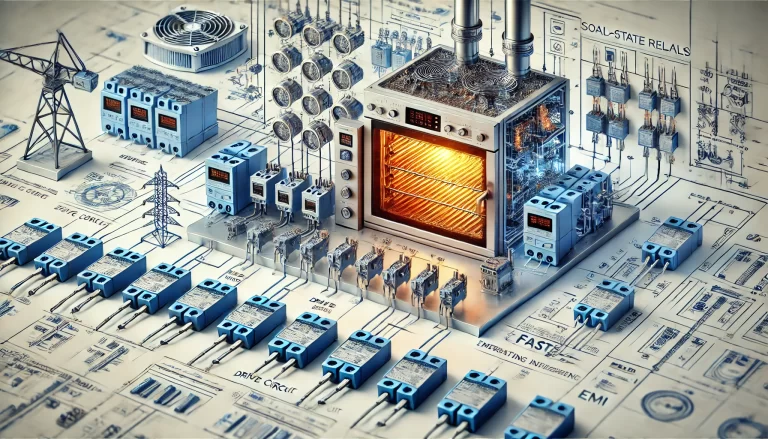
6. Relay
A relay is an electrically operated switch that uses a small current to control a larger current in another circuit. It allows one circuit to control another without a direct electrical connection between the two.
Function:
Relays are commonly used for electrical isolation between high and low-voltage circuits. They also provide protection by allowing circuits to handle high-power loads that a simple switch might not handle safely.Types:
- Electromagnetic Relay: Uses an electromagnet to mechanically operate a switch.
- Solid-State Relay: Uses semiconductor components to switch without moving parts.
Applications: Used in automotive systems, home appliances, and industrial controls.
7. Switch
Switches are simple devices used to control the on/off state of an electrical circuit.
Function:
They allow or stop the flow of current in a circuit. Switches can be manually or automatically operated and are used in virtually every electronic device for controlling power or signal flow.Types:
- Toggle Switch: Manually operated by flipping a lever.
- Push Button Switch: Activated by pressing a button.
- Rotary Switch: Changes the connection by rotating a knob.
Applications: Found in everything from household appliances to industrial machinery and consumer electronics.
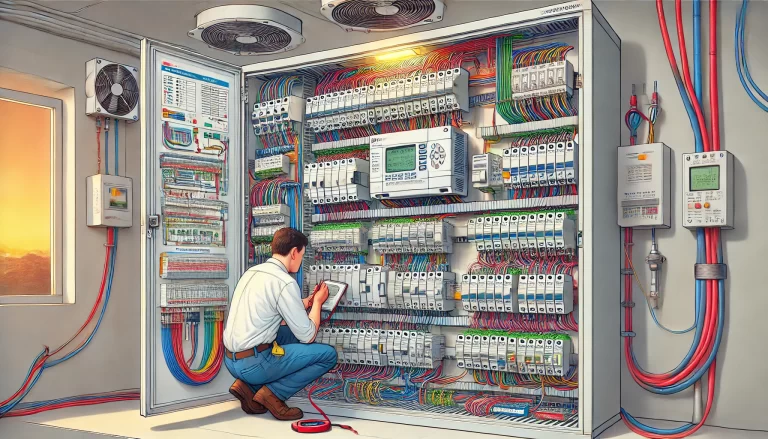
8. Transformer
A transformer is a device that transfers electrical energy between two or more circuits through electromagnetic induction. It is primarily used to step up (increase) or step down (decrease) voltage levels.
Function:
Transformers play a critical role in power distribution by ensuring that electricity is transmitted efficiently over long distances. They can also be used in electronic devices to isolate different parts of a circuit and ensure safety.Types:
- Step-up Transformer: Increases voltage from the primary to secondary winding.
- Step-down Transformer: Reduces voltage for use in lower-voltage circuits.
Applications: Used in power distribution systems, electrical isolation, and audio systems.
9. Fuse
A fuse is a safety device that protects an electrical circuit from overcurrent by “blowing” or melting when the current exceeds a safe level.
Function:
Fuses are essential for preventing damage to electrical components and reducing the risk of fire due to overheating. When the fuse blows, it breaks the circuit, preventing any further flow of current until the fuse is replaced.Types:
- Glass Fuse: A small, transparent tube that shows if the fuse is blown.
- Ceramic Fuse: Offers better heat dissipation and is used in high-power applications.
Applications: Used in household appliances, automotive systems, and industrial equipment for overcurrent protection.
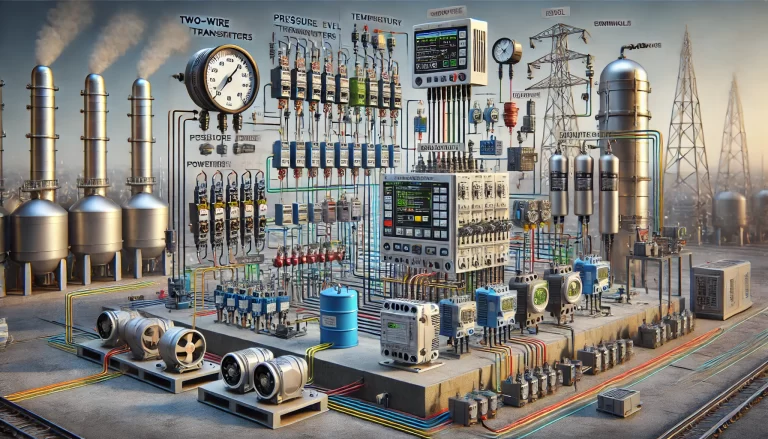
10. Bridge Rectifier
A bridge rectifier is a configuration of four diodes arranged in a bridge circuit. It is used to convert alternating current (AC) to direct current (DC).
- Function:
The bridge rectifier ensures that the current flows in only one direction, effectively transforming AC into DC. This makes it a key component in many power supply circuits.
Applications: Used in power supply units to provide a stable DC output from an AC input.
Conclusion
Each of these electrical components plays a unique and crucial role in the functioning of electronic devices and systems. From controlling current with resistors to converting AC to DC with rectifiers, these components work together to create complex circuits that power everything from smartphones to industrial machinery. Understanding the function and application of these components is essential for anyone working in electronics or electrical engineering.
